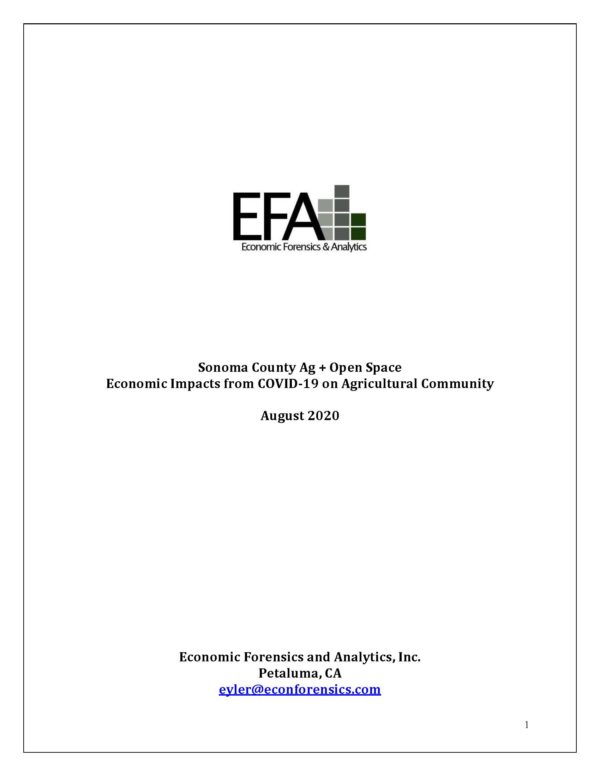September 29, 2020
Posted in: News Articles
Economic Impacts from COVID-19 on Agricultural Community
In response to the impacts of the COVID-19 pandemic on the Sonoma County agricultural community, Sonoma County Ag + Open Space commissioned an economic study to examine the effects of the pandemic on food-producing businesses in Sonoma County from 2020 to 2023. The study, undertaken by Dr. Robert Eyler, president of Economic Forensics and Analytics, Inc., predicts between 9.7 percent and 19.2 percent in lost value for local producers in 2020, which amounts to a value of approximately $32 million to nearly $64 million. The study also found that food producers will likely not see recovery in the value of their products until at least 2022.
The full report is available here >>
“While the COVID-19 pandemic has affected nearly all aspects of life in Sonoma County, our agricultural community has suffered significant economic impacts due to disruptions in the food system, supply chains, processing, and storage capacity,” said Susan Gorin, Chair of the Ag + Open Space Board of Directors and First District Supervisor. “We knew the economic impact would be significant and we’re grateful to Dr. Eyler for giving us the hard numbers so we can respond accordingly in the short term, as well as plan for the future.”
Using the crops and livestock in the Annual Crop Report from the Sonoma County Agricultural Commissioner, Dr. Eyler assessed the range of lost value based on the projected risks for the major agricultural products in Sonoma County, as well as state and national job losses projected for restaurants, retail, distribution, processing, and agriculture until the end of 2020. Winegrape and cannabis production were not considered in the report. In addition to assessing the losses this year, he also looked at possible recovery scenarios. According to the report, the best case scenario is that agricultural values will recover by 2022, however the more likely scenario is that recovery will not come until 2023.
“Several factors have contributed to the loss of value,” said Dr. Eyler. “Interestingly enough, the primary factors are not related to harvest or production, but rather the many disruptions in the supply chain including decreased demand from retail and restaurant markets, processing and packaging plant closures or delays, farmers’ market closures, and delays or disruptions at feed lots and storage facilities.”
The report also includes a deeper look at the challenges already facing Sonoma County food producers, including lack of regional processing facilities for crops and livestock, lack of agricultural diversity, volatile price dynamics, and the rising costs of doing business and owning land.
“The devastating impact the pandemic has had on our agricultural producers cannot be overstated,” said Tawny Tesconi, Executive Director of the Sonoma County Farm Bureau. “Dr. Eyler’s study simply underscores what our members have been experiencing since March. So many of our agricultural producers were already struggling and this pandemic has exposed and exacerbated the challenges our multi-generational farming and ranching families were facing.”
Even before receiving the final report from Dr. Eyler, Ag + Open Space began working on the Agricultural Support and Protection (ASAP) Emergency Grant Program to provide much-needed financial assistance to agricultural businesses in Sonoma County. The ASAP program will provide up to $1 million to producers at risk of losing their agricultural operations as a result of the pandemic. In addition, Ag + Open Space is working with members of the diverse agricultural community in Sonoma County to understand and to help address existing and potential future challenges facing agricultural producers as a result of climate change, increased housing and land costs, labor shortages, and changes in market demand.
“Supporting our local farmers and ranchers has always been a cornerstone of Ag + Open Space,” said General Manager, Bill Keene. “In addition to working with willing landowners to protect agricultural lands as we’ve done for nearly 30 years, we are committed to looking at new and innovative ways to maintain a thriving agricultural economy as conditions change and new challenges arise.”
